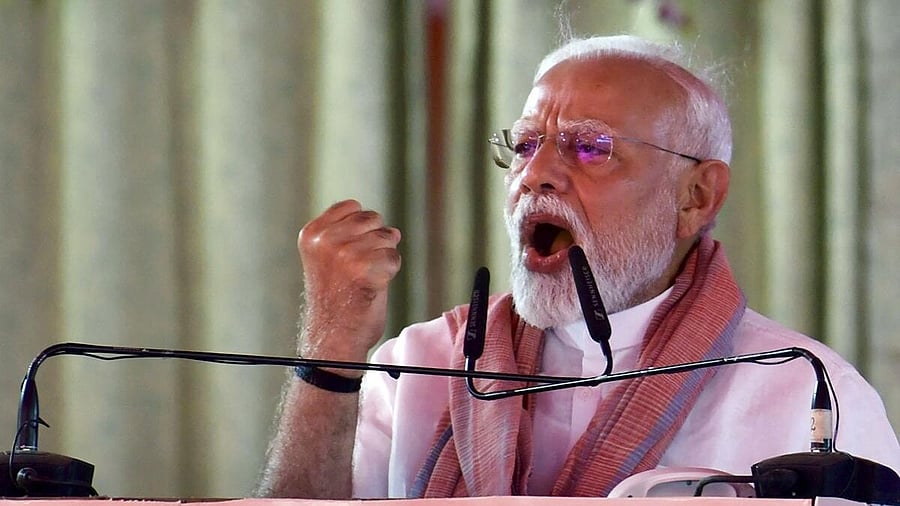
PM Narendra Modi addressing a rally in Bihar.
Credit: PTI Photo
Like any other election in the last decade, especially after 2014 Lok Sabha polls, the 'Modi factor' looms large over the 2025 Bihar Assembly elections also. Though, its influence is complex, conditional, and contested. While Prime Minister Narendra Modi still remains a central campaign figure for the National Democratic Alliance (NDA) in Bihar, his appeal must be in sync with caste coalitions, regional and political aspirations and electoral engineering. In all this, BJP can't afford to ignore youth anxiety and economic upliftment of one the least developed states of the country.
Leveraging the Central brand
One clear asset for the BJP is Modi’s clean image and pan-India influence. The NDA has repeatedly invoked central schemes, national momentum, and Prime Minister Modi’s leadership in campaign messaging.
In just the recent weeks, the PM has rolled out high-value welfare transfers to women, mega development project inaugurations, and youth-oriented schemes in Bihar — broad gestures intended to translate into votes.
In financial transfers alone, Modi’s government deposited Rs 7,500 crores into accounts of 75 lakh women in Bihar, in a scheme that critics say is timed to influence political sentiment. While making the announcement, Modi addressed women gathered in multiple locations in the state, and said, 'I see millions of women on the screen, and their blessings are a great source of strength for all of us.'
'The women's employment plan is being launched today. So far, 75 lakh women have joined this scheme, and an amount of Rs 10,000 has been transferred to the bank accounts of all these women," he said.
Such moves may sway undecided voters or those at the margins, especially where local leadership is weak. Congress General Secretary Jairam Ramesh termed this step as nothing but a copy of Karnataka govt's Griha Lakshmi scheme in which 1.3 crore women in the state are getting Rs 2,000 per month. Ramesh also said that the BJP is involved in both - 'Vote-chori and Vote-revadi'
Constraints and limitations
In Bihar, voters tend to prioritise regional leadership and state issues over purely national narratives - for example, 2015 results. Despite the high-voltage campaign strategy of BJP, Mahagathbandhan (JD(U) + RJD + Congress) easily won. On some occasions when the contest is with a strong regional satrap like RJD, the central appeal may be less decisive.
Nitish Kumar’s dominance and his long tenure as Bihar’s political pivot also complicate BJP’s claim to go it alone. Over the past few years, the BJP has gradually asserted greater influence within the NDA in Bihar. But this rise has been at the cost of its partner JD(U) only and BJP has not been able to influence the support base of main opponent RJD.
There BJP has to do delicate balancing act. If BJP goes all out in the state and Modi’s imprint becomes too heavy, Nitish’s base might feel sidelined.
Another formidable obstacle is anti-incumbency. Across many constituencies, voters are frustrated with slow job creation, migration pressures, and unmet promises. Even as Modi’s central schemes aim to counter this, they may not fully erase voter discontent at the grassroots.
Electoral engineering, roll revision, and the Modi shadow
A less subtle dimension of the Modi factor is connected to the electoral processes themselves. The special intensive revision (SIR) of voter rolls in Bihar has ignited sharp controversy, with opposition parties accusing the ECI of deliberately purging anti-BJP voters under cover of 'cleaning the list.'
While the BJP and its allies deny targeting, the timing and scale of deletions have elevated doubts about fairness.
In that backdrop, the Modi factor becomes not only a campaign brand but a subtle instrument: the risk of suppression of marginal voter blocs could amplify central advantage. That said, allegations of manipulation are also rallying points for Opposition campaigns, especially among youth, Dalits, and Muslims.
Outlook: Conditional, but potent
In sum, Modi’s appeal is an important weapon in BJP's arsenal party's Bihar strategy but is it decisive? Many factors will decide its impact. Central policies' traction among locals and the anti-incumbency against Nitish Kumar who has been in office for almost 25 years will also decide the fate of the state on November 14.
BJP has to also ensure that alliances with other parties are forged without alienating regional bases. There are smaller yet relevant players like Chirag Paswan, Upendra Kushwaha, Jitan Ram Manjhhi, and others who are influential in pockets of Bihar.
If NDA has to cross the majority mark, it cannot be done without the Modi factor at play in swing seats — especially where caste arithmetic is fragmented, and local leaders lack credibility. This could very well tilt the balance in favour of NDA. The Central pull will have a challenge on many seats in face of deeply rooted in regional dynamics, caste alliances, and local grievances. This might also a space for the Opposition to resist or even overcome the Central pull coming from the Modi factor.